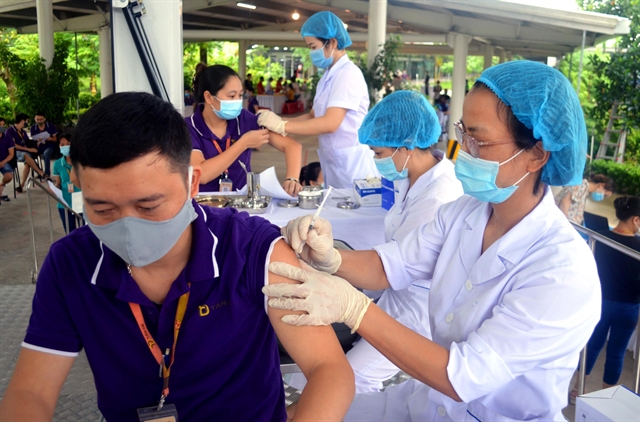 Opinion
Opinion


|
| Employees of a factory in the northern province of Thái Bình are inoculated against COVID-19. VNA/VNS Photo Thế Duyệt |
HÀ NỘI — As it is unfeasible to pursue a ‘Zero COVID’ policy, Việt Nam needs to have plans to live with COVID-19, minimise deaths from the disease and control outbreaks, according to Director of the Central Lung Hospital Nguyễn Viết Nhung.
COVID-19 variants make it almost impossible to isolate all infected cases from the community.
Associate Professor, Dr. Nhung said: “It was our goal to isolate all infected cases from the community, however, given the current context, the goal is not feasible and suitable anymore.”
He said that the coronavirus mutates very quickly and they are infectious for a shorter period, similar to influenza viruses, therefore their existence will be long-term.
No country in the world has been successful in isolating COVID-19 from the community. Vaccines, which have been the best way to control the pandemic so far, also fail to eliminate COVID-19 completely.
“The COVID-19 vaccine does not prevent infection, but only alleviates clinical symptoms and significantly reduces mortality caused by the disease. This is similar to the tuberculosis vaccine which only reduces the incidence of severe tuberculosis among children,” the doctor said.
The past four waves of infection showed that the Zero COVID policy is not a sustainable way, he said.
About 84 per cent of all infected cases are asymptomatic or have minor symptoms, which means that they only suffer upper respiratory tract infection and do not have their lungs attacked by the virus, he said.
Only 16 per cent have lungs infected, of which 5 per cent are in critical and severe conditions and 11 per cent have mild conditions.
Deaths are seen mostly in the old age group and those with underlying health conditions. Those above 60 with many underlying conditions have a higher risk of getting more severe symptoms and dying.
Nhung also noted that the death rate varies in different localities with HCM City (4 per cent), Tiền Giang Province (2.5 per cent), Bình Dương and Đồng Nai provinces (under 1 per cent).
He said that the death rate depends on four factors. They are the total number of cases and growth rate of infections, the capacity of the health system with different levels of severity and treatment, coordination and classification capacity, preventive intervention capacity (including testing, identifying outbreaks, isolating outbreaks and quarantine plans).
Nhung said that though Italy was among the countries hardest hit by the COVID-19 pandemic in 2020, it controlled it quite well in 2021 and research showed that treating COVID-19 patients at home is among factors attributed to the success of Italy.
“To prepare for a new normalcy amid COVID-19, we can just live with the pandemic safely, minimise deaths and control outbreaks,” the doctor said.
He suggested criteria to get back to the new normalcy including the rate of people complying with 5K, the rate of hospitalisation and deaths from COVID-19, the vaccination rates (with top priority given for vulnerable groups like people above 60 and people with underlying conditions).
It is also necessary to take into account other factors including data about the number of new outbreaks, the rate of infections in 100,000 people, as well as capacity indicators like the number of ICU beds, the number of localities that have sufficient capacity for testing, and identifying outbreaks.
He said it is also necessary to study and evaluate the pandemic situation in terms of both pathological characteristics and variants while carrying out key testing and isolating in the community (minimise gatherings).
It is crucial to use rapid antigen testing and only conduct mass testing when necessary.
“Mass testing is required only when the pandemic situation is out of control. The purpose of mass testing is to identify outbreaks and then have intervention measures to control them,” he said.

|
| Residents in Khương Đình Ward, Thanh Xuân District were tested for COVID-19 in late August. VNA/VNS Photo Tuấn Anh |
He said strong local health systems are needed to apply quarantine in the community model.
The local health systems must be capable of receiving infected cases who have minor and mild conditions while local people should be allowed to access COVID-19 tests and minor cases can be treated at home shall they meet the requirements needed, the director of the central lung hospital said.
He added that local people and local health facilities need to work closely with each other.
Measures and policies related to COVID-19 prevention and control must be based on scientific grounds and adjusted in accordance with reality. The opening or closure orders must be based on transparent criteria and should be made public so they understand and comply with them.
The level of risk should be classified based on the characteristics and complexity of the outbreak, not just the geography.
The doctor said strong and consistent management and direction are crucial to achieving these measures.
He said it is important to have full vaccine coverage for the vulnerable group (those above 60 and those with underlying health conditions) and then have full vaccine coverage for the general public.
“It’s vaccine source that matters. We need the participation of the private sector so we can access a large amount of vaccines at a reasonable price as soon as possible,” Nhung said. — VNS